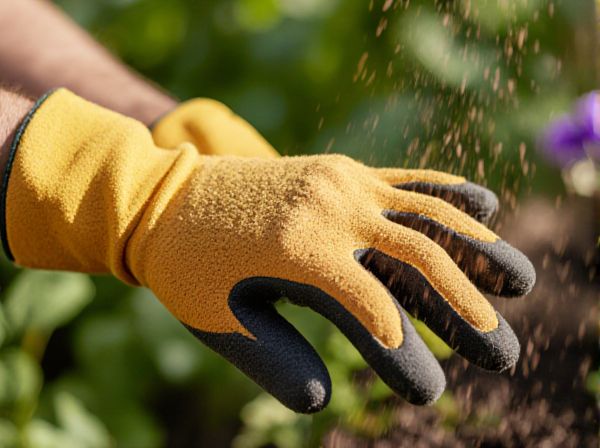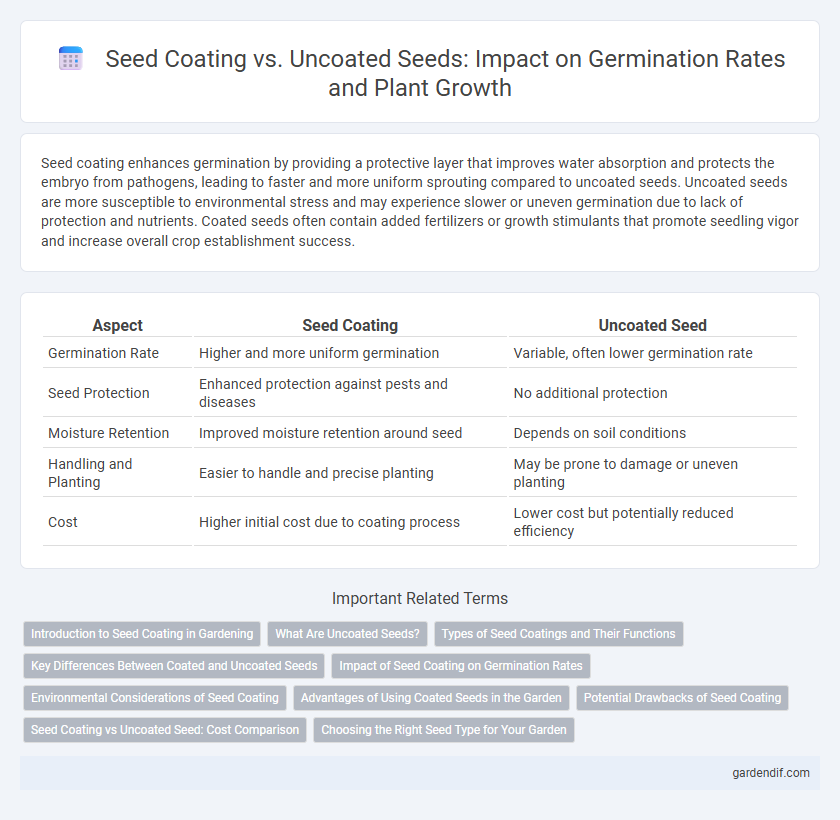
Seed Coating vs Uncoated Seed Illustration
Seed coating enhances germination by providing a protective layer that improves water absorption and protects the embryo from pathogens, leading to faster and more uniform sprouting compared to uncoated seeds. Uncoated seeds are more susceptible to environmental stress and may experience slower or uneven germination due to lack of protection and nutrients. Coated seeds often contain added fertilizers or growth stimulants that promote seedling vigor and increase overall crop establishment success.
Table of Comparison
| Aspect | Seed Coating | Uncoated Seed |
|---|---|---|
| Germination Rate | Higher and more uniform germination | Variable, often lower germination rate |
| Seed Protection | Enhanced protection against pests and diseases | No additional protection |
| Moisture Retention | Improved moisture retention around seed | Depends on soil conditions |
| Handling and Planting | Easier to handle and precise planting | May be prone to damage or uneven planting |
| Cost | Higher initial cost due to coating process | Lower cost but potentially reduced efficiency |
Introduction to Seed Coating in Gardening
Seed coating enhances germination by providing a protective layer that improves moisture retention and nutrient availability compared to uncoated seeds. Coated seeds facilitate easier sowing, better seedling establishment, and increased resistance to soil pathogens, leading to higher germination rates. This technique is particularly beneficial in gardening, where uniform seed distribution and improved seedling vigor are critical for successful plant growth.
What Are Uncoated Seeds?
Uncoated seeds are natural seeds that have not undergone any treatment or protective layering, allowing for direct contact with soil and moisture during germination. These seeds maintain their original size, weight, and texture, making them highly susceptible to environmental factors such as pests, diseases, and uneven moisture levels. Unlike coated seeds, uncoated seeds rely solely on intrinsic seed properties and external soil conditions for successful germination and growth.
Types of Seed Coatings and Their Functions
Polymer, film, and pelleting are common types of seed coatings that enhance germination by improving moisture retention and protecting against pathogens. Inert coatings add physical protection and facilitate mechanical sowing without affecting seed viability. Biodegradable coatings can deliver nutrients or pesticides directly to seeds, boosting early seedling vigor and overall crop performance.
Key Differences Between Coated and Uncoated Seeds
Coated seeds feature a protective layer that enhances moisture retention, improves sowing precision, and often contain nutrients or pesticides for better germination rates, unlike uncoated seeds which are raw and more susceptible to environmental stress. The physical coating allows coated seeds to have uniform size and shape, facilitating mechanical planting and reducing seed loss. Uncoated seeds generally exhibit natural germination variability and slower initial growth due to direct exposure to soil conditions without added protection or treatment.
Impact of Seed Coating on Germination Rates
Seed coating enhances germination rates by providing a protective barrier against pathogens, pests, and environmental stresses, creating optimal conditions for seedling emergence. Coated seeds often exhibit improved moisture retention and uniform germination timing compared to uncoated seeds. However, the specific impact on germination depends on the composition of the coating material and seed species.
Environmental Considerations of Seed Coating
Seed coating often includes polymers and chemical additives that can affect soil health by altering microbial activity and potentially introducing toxins, raising environmental concerns compared to uncoated seeds. Uncoated seeds minimize chemical runoff and reduce ecological disruption, promoting more sustainable germination practices. Biodegradable and eco-friendly coatings are emerging to balance enhanced germination rates with environmental safety.
Advantages of Using Coated Seeds in the Garden
Coated seeds enhance germination rates by providing a protective layer that retains moisture and shields seeds from pests and diseases, leading to more consistent seedling emergence. The uniform size and shape of coated seeds facilitate easier and more precise planting, improving overall garden efficiency. Nutrient-rich coatings also supply essential microelements directly to the seed, promoting faster early growth and stronger plant development compared to uncoated seeds.
Potential Drawbacks of Seed Coating
Seed coating can sometimes hinder germination by restricting water uptake and oxygen diffusion essential for seed metabolic activation. Coatings may also introduce chemicals that inhibit seedling growth or alter the seed's natural microenvironment. Uncoated seeds avoid these risks, often exhibiting more consistent and faster germination rates under optimal soil conditions.
Seed Coating vs Uncoated Seed: Cost Comparison
Seed coating increases upfront costs due to materials and application processes, but it often enhances germination rates, reducing overall expenses related to replanting and crop failure. Uncoated seeds have lower initial costs but may require higher quantities or additional treatments to achieve optimal germination, potentially raising long-term expenditures. Cost-benefit analysis indicates that seed coating can offer better economic efficiency by improving seed performance and reducing labor and resource inputs during cultivation.
Choosing the Right Seed Type for Your Garden
Selecting between seed coating and uncoated seeds significantly influences germination success and crop yield. Seed coatings often improve moisture retention, protection from pests, and uniform germination rates, making them ideal for challenging soil conditions or small-scale precise planting. Uncoated seeds remain a cost-effective choice, suited for gardeners prioritizing organic practices and natural growth cycles where soil quality is already optimal.
Seed Coating vs Uncoated Seed Infographic

 gardendif.com
gardendif.com